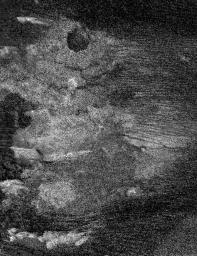
|
Radar Images Shikoku - “Great Britain”
- Click the image above for a larger view
- Full-Res JPEG (850 x 1107) (331.6 kB)
- Full-Res TIFF (850 x 1107) (942.2 kB)
Caption:
This image of Saturn's moon Titan from the Synthetic Aperture Radar instrument on the Cassini spacecraft shows Shikoku Facula, a region that is bright in both radar and visible wavelengths. This radar image was taken on April 30, 2006. For a visible-light image of Shikoku Facula see PIA07752 .
A circular feature with a radar-dark interior, probably an impact crater, is seen near the top of the image and is about 35 kilometers (22 miles) in diameter. Numerous linear dark features are seen running across the image, mostly on the right-hand side. These features were seen on other radar images (see PIA08425 and PIA03567 ) and interpreted as dune fields. Bright, ridge-like features mainly on the lower half of the image may be topographically high regions. Radar-dark, thin, sinuous features, which may be channels draining from the bright to the dark regions, are seen below the circular feature.
Background Info:
The Cassini-Huygens mission is a cooperative project of NASA, the European Space Agency and the Italian Space Agency. The Jet Propulsion Laboratory, a division of the California Institute of Technology in Pasadena, manages the mission for NASA's Science Mission Directorate, Washington, D.C. The Cassini orbiter was designed, developed and assembled at JPL. The radar instrument was built by JPL and the Italian Space Agency, working with team members from the United States and several European countries.
For more information about the Cassini-Huygens mission visit http://saturn.jpl.nasa.gov/home/index.cfm .
Cataloging Keywords:
| Name | Value | Additional Values |
|---|---|---|
| Target | Titan | |
| System | Saturn | |
| Target Type | Satellite | |
| Mission | Cassini-Huygens | |
| Instrument Host | Cassini Orbiter | |
| Host Type | Orbiter | |
| Instrument | Radar Mapper | |
| Detector | ||
| Extra Keywords | Crater, Dune, Grayscale, Impact, Radar | |
| Acquisition Date | ||
| Release Date | 2006-05-03 | |
| Date in Caption | 2006-04-30 | |
| Image Credit | NASA/JPL-Caltech/ASI | |
| Source | photojournal.jpl.nasa.gov/catalog/PIA08426 | |
| Identifier | PIA08426 | |
